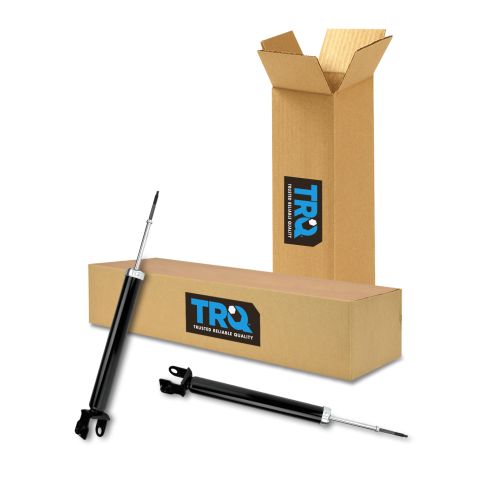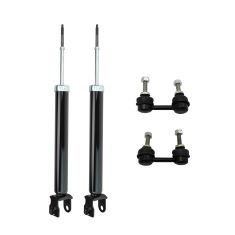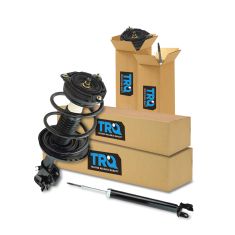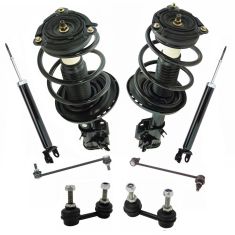1ASSP00830-2007-18 Nissan Altima Rear Driver & Passenger Side 2 Piece Shock Absorber Set TRQ SBA60360

Replaces
2018 Nissan Altima Rear Driver & Passenger Side 2 Piece Shock Absorber Set TRQ SBA60360

Product Reviews
Loading reviews
4.89/ 5.0
18
18 reviews
Works as advertised
March 3, 2017
Had no issues with the installation. They work great! Inexpensive!
Fantastic
July 27, 2017
I have already told the UPS guy how to buy from you. H
Shock absorber pair
October 20, 2018
I found myself needing more parts and guess what this is the place to go. My car again rides much better and Id recommend this 1a to anyone. The prices are affordable.
Work great!
November 10, 2018
I have a 2010 Altima. Replaced the rear shocks two years ago with Monroe's that I purchased from an auto parts store. The cost was $96. a piece. The driver's rear was bad on the new shocks. Of course it took awhile to figure it out. I recently bought these and they seem great, nice ride, tires not cavitating like before. Way cheaper too, very happy.
Great product and great company
October 28, 2019
I am currently in Afghanistan and bought these rear shocks for a car I purchased while I was out here. The shopping experience with this company online is amazing. The tool they provide to select your car and all their products makes shopping online extremely easy. Every time that I have looked on their site they always have amazing deals for extremely reliable parts. When they showed up to my house there was no issue. Not to mention they arrived in two days and I did not pay shipping at all. I had my wife take them to our mechanic and get them put on and he was pretty impressed with the quality of shocks that I received for a killer price. My wife has been driving the car with these shocks on them and she can drive on the bumpiest of roads. I will be recommending 1A Auto to all my family and friends and will continue to be a customer for years to come.
Shocks
November 18, 2019
Perfect fit. The car rides great.
Perfect fit
April 20, 2020
High quality parts at a reasonable price. The online instructions made installation a snap. I will buy from them again.
Shocks
September 3, 2021
So far so good
November 20, 2021
Fit like original parts
Good products
April 21, 2022
Fit prefect on my car
September 28, 2022
Fit just like originals
October 29, 2022
Love it
Altima Rear Shocks.
December 17, 2022
These are a great replacement for OEM shocks. Quality and ease of installation were both fantastic.
5 Stars
May 18, 2023
Perfect fit, car drives a lot smoother when traveling on the interstate. It definitely eliminated that bouncy feel. Thanks
June 4, 2023
Direct fit and good part.
Parts
July 25, 2023
Excellent quality and fantastic price but I do with the top came with a few things that you have to take off the old one to make installation faster and easier
October 2, 2023
Fit my 2010 Nissan altima perfectly and no issues after installation
Great products at great prices
October 3, 2023
Fast shipping...great solid product..fit like a glove...will definitely come back
Customer Q&A
Can you return product if it doesn't fit ?
August 15, 2016
10
Items are returnable. Please be aware you shall be responsible for items not fitting and must be in clean, new and unmarked condition. 1A supplied all details needed to verify fit for the item listed. Please review and research any details you need before ordering.
August 15, 2016
Brian F
10
great parts
May 22, 2018
Everton S
does this include the Bushing Kit for each shock?
March 3, 2023
10
Hello, no this doesn't come with any bushings.
March 4, 2023
Ricale A
10
Hello, I apologize however there is not any bushings in our images, and we do not carry the bushings. you could try to source those locally.
March 7, 2023
Ricale A
Does this come with the bushing kit as shown in picture ?
October 2, 2023
10
Yes comes with all new parts except i think the mounting plate and nuts to put it on and the dust boot cover
October 3, 2023
GAGIK S
10
Yes, the bushing kit will be included.
October 5, 2023
Jessica D
Nissan is a registered trademark of Nissan Motor Co., Ltd. 1A Auto is not affiliated with or sponsored by Nissan or Nissan Motor Co., Ltd.
See all trademarks.













